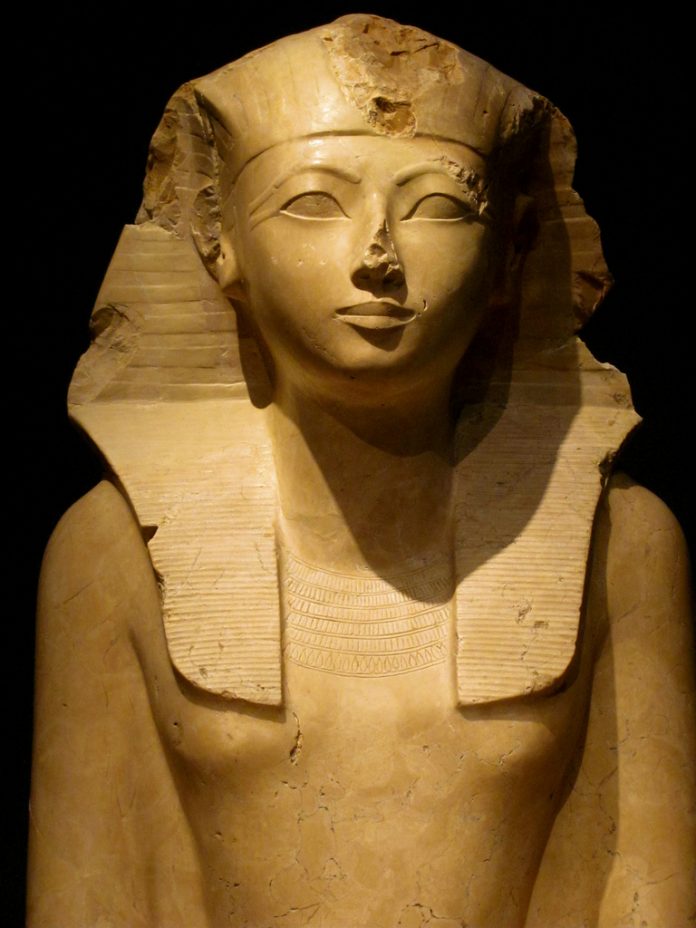She was real, she lived once, and she had more power than perhaps any woman in world history. But still she disappeared from all fairy tales and stories; her memory was literally cut away from rock walls and tomb chapels, from temple walls and memorial statues – before she was finally rediscovered. This is the story of Hatshepsut, the mistress of Egypt, whose name for countless years was not even allowed to be pronounced.
A female pharaoh
When scientists in the 19th century finally learned to read Egypt’s ancient written language, the hieroglyphs, a whole new and fantastic world of knowledge opened up. But it was often really difficult to understand.
Jean-Francois Champollion himself, the Frenchman who once and for all solved the mystery of the hieroglyphs, was confronted with one of these mysteries, as he tried to decipher the writing on the temple walls of the huge Deir el-Bahri burial complex outside Luxor. There he could read about the mighty Moeris, also known as Thutmosis III, one of the greatest recognized of all the pharaohs of Egypt. But it also mentions its predecessor, Amenenthe. This pharaoh is depicted as all the country’s rulers, with the typical loose beard and the typical royal costume. But there is something strange about how the text is formulated. The pharaoh is mentioned as a woman. “Her Majesty the King”, roughly.
“It’s very puzzling,” Champollion wrote in a letter. “I find the same weirdness everywhere…”
Only eventually will the truth be revealed. Amenenthe was in fact a name written there in retrospect, to hide the fact that there once existed a female pharaoh named Hatshepsut. She had ruled the vast empire for twenty-two years and had also been very successful. Under her leadership, several wars had been won and a rich trade with the outside world established. Countless huge building projects were started, and so many statues and sculptures were erected that there are not many museums in the world with an interest in ancient Egypt that do not have at least some work from Hatshepsut’s time in their exhibition halls.
Yet for almost three thousand years she was completely forgotten. How was that possible?
The memory of Hatshepsut is cleared …
Careful detective work could finally reveal the truth. It was Thutmosis III, her powerful heir, who towards the end of her long reign decided to clear out all the memories of the woman who had been his mother-in-law. Hatshepsut’s name was removed from official archives and pictures depicting her were destroyed, in temples and tomb complexes. Sculptures had their faces smashed, before being thrown into deep pits and covered with sand and mud. And soon the memory of Hatshepsut’s long reign was gone.
Only the fact that her name and image have been preserved in so many places, in hidden corners of temple buildings and deep inside long-covered tomb chapels, meant that archaeologists would later rediscover her; only then could she be highlighted as one of the most important rulers in Egypt’s millennial history .
Why then did Thutmosis do this? A first interpretation was that it was an expression of a personal need for revenge. Perhaps he hated his mother-in-law, who was believed to have intrigued her to the throne, and then kept him out of power for far too many years. Maybe that was why he immediately struck back, by trying to eradicate the very memory of the person he so hated?
That interpretation has now been abandoned. Not least because it has turned out that Thutmosis seems to have had an at least decent relationship with her mother-in-law, at least judging by the fact that she actually gave him power over the country’s army while she was still alive. In addition, the attacks on her memory did not begin until the end of Thutmosi’s reign, more than twenty years after her death. Hardly the way a man would act if he were full of hatred and vengeance.
… the men’s monopoly of power is reaffirmed
Perhaps, at least argues the English archaeologist Joyce Tyldesley, it was all about an attempt to restore what was perceived as a kind of natural order of nature, a precondition for the cosmic balance – that men should rule over women. By obliterating her from history, the dynastic order was restored; power seemed to have been inherited in safe succession from one man to the next.
Admittedly, women in Egypt had relatively great independence, measured by ancient standards. They could make a career, and divorce without having to be ashamed of it. But female rulers were rare. Although in exceptional cases it was always about more or less temporary solutions, which left no great traces behind, really nothing that could be used to question the basic principle of male supremacy.
For this is an unpleasant truth that is difficult to ignore for anyone who takes a look at the history of mankind. Almost without exception, men have had the power, and moreover claimed that this is the way it obviously must be. Women are not capable of governing, it has been called, through the ages and across virtually the entire earth.
Hatshepsut questions this statement. She shows that a woman can be as strong, as successful, as near-divine, as any penis-bearing homo sapiens. Maybe that’s why Thutmosis III so desperately wanted to erase her from all living people’s memories?
Who knows what future women would otherwise get for themselves… Maybe they would not accept their lot as at most the wife, sister or mother of a powerful man, but start making demands on real power, on real influence?
Thank you for reading! Please share this article to give us credit.

